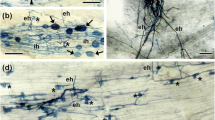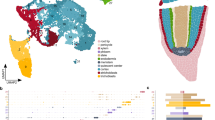Summary
The early events in the development of nodules induced byBradyrhizobium japonicum were studied in serial sections of a wild type (cv. Bragg), a supernodulating mutant (nts 382) and four non-nodulating mutants (nod49, nod139, nod772, andrj 1) of soybean (Glycine max [L.] Merrill). Cultivar Bragg responded to inoculation in a similar manner to that described previously for cv. Williams; centres of sub-epidermal cell divisions were observed both with and without associated infection threads and most infection events were blocked before the formation of a nodule meristem. The non-nodulating mutants (nod49, nod772, andrj 1) had, at most, a few centres of sub-epidermal cell divisions. In general, these were devoid of infection threads and did not develop beyond the very early stages of nodule ontogeny. Sub-epidermal cell divisions or infection threads were never observed on mutant nodl39. This mutant is not allelic to the other non-nodulating mutants and represents a defect in a separate complementation group or gene that is required for nodulation. The supernodulating mutant nts382, which is defective in autoregulation of nodulation, had a similar number of sub-epidermal cell divisions as the wild-type Bragg, but a much greater proportion of these developed to an advanced stage of nodule ontogeny. Mutant nts382, like Bragg, possessed other infection events that were arrested at an early stage of development. The results are discussed in the context of the progression of events in nodule formation and autoregulation of nodulation in soybean.
Similar content being viewed by others
Abbreviations
- nts:
-
nitrate tolerant symbiosis
- RT:
-
root tip (i.e., position of the tap root tip at the time of inoculation)
- SERH:
-
shortest emerging root hair (i.e., position of the shortest emerging root hair on the tap root at the time of inoculation)
- SCD:
-
subepidermal cell divisions
References
Alva AK, Edwards DG, Carroll BJ, Asher CJ, Gresshoff PM (1988) Modulation and early growth of soybean mutants with increased nodulation capacity under acid soil infertility factors. Agron J 80: 836–841
Bauer WD (1981) Infection of legumes by rhizobia. Ann Rev Plant Physiol 32: 407–449
—, Bhuvaneswari TV, Calvert HE, Law IJ, Malik NSA, Vesper SJ (1985) Recognition and infection by slow-growing rhizobia. In: Evans HJ, Bottomley PJ, Newton WE (eds) Nitrogen fixation research progress. Martinus Nijhoff, Dordrecht, pp 247–253
Bhuvaneswari TV, Turgeon BG, Bauer WD (1980) Early events in the infection of soybean (Glycine max L. Merr.) byRhizobium japonicum. I. Location of infectible root cells. Plant Physiol 66: 1027–1031
Callaham DA, Torrey JG (1981) The structural basis for infection of root hairs ofTrifolium repens byRhizobium. Can J Bot 59: 1647–1664
Calvert HE, Pence MK, Pierce M, Malik NSA, Bauer WD (1984) Anatomical analysis of the development and distribution ofRhizobium infections in soybean roots. Can J Bot 62: 2375–2384
Carroll BJ, Mathews A (1989) Nitrate inhibition of nodulation in legumes. In: Gresshoff PM (ed) The molecular biology of nitrogen fixation. CRC Publishers, Boca Raton, in press
—, McNeil DL, Gresshoff PM (1984) Breeding soybeans for increased nodulation in the presence of external nitrate. In: Ghai BS (ed) Symbiotic nitrogen fixation. USG Publishers and Distributors, Ludhiana, pp 43–50
— — — (1985 a) A supernodulation and nitrate tolerant symbiosis (nts) soybean mutant. Plant Physiol 78: 34–40
— — — (1985 b) Isolation and properties of soybean [Glycine max (L.) Merr.] mutants that nodulate in the presence of high nitrate concentrations. Proc Natl Acad Sci USA 82: 4162–4166
— — — (1986) Mutagenesis of soybean [Glycine max (L.) Merr.] and the isolation of non-nodulating mutants. Plant Sci 47: 109–114
Dudley ME, Jacobs TW, Long SR (1987) Microscopic studies of cell divisions induced in alfalfa roots byRhizobium meliloti. Planta 171: 289–301
Finan TM, Hirsch AM, Leigh JA, Johansen E, Kuldau A, Deegan S, Walker GC, Signer ER (1985) Symbiotic mutants ofRhizobium meliloti that uncouple plant from bacterial differentiation. Cell 40: 869–877
Hirsch AM, Drake D, Jacobs TW, Long SR (1985) Nodules are induced on alfalfa roots byAgrobacterium tumefaciens andRhizobium trifolii containing small segments of theRhizobium meliloti nodulation region. J Bacteriol 161: 223–230
—, Wilson KJ, Jones JDC, Bang M, Walker VV, Ausubel FM (1984)Rhizobium meliloti nodulation genes allowAgrobacterium tumefaciens andEscherichia coli to form pseudonodules on alfalfa. J Bacteriol 158: 1133–1143
Jensen HL (1942) Nitrogen fixation in leguminous plants. I. General characteristics of the root nodule bacteria isolated from species ofMedicago andTrifolium. Aust Proc Linn Soc 66: 98–108
Jensen WA (1962) Botanical histochemistry. WH Freeman, San Francisco
La Favre JS, Eaglesham ARJ (1984) Increased nodulation of “non-nodulating” (rj 1 rj 1) soybeans by high dose inoculation. Plant Soil 80: 297–300
Libbenga KR, Harkes PAA (1973) Initial proliferation of cortical cells in the formation of root nodules inPisum sativum L. Planta 114: 17–28
Mathews A, Carroll BJ, Gresshoff PM (1987) Characterization of non-nodulation mutants of soybean [Glycine max (L.) Merr.]:Bradyrhizobium effects and the absence of root hair curling. J Plant Physiol 131: 349–361
- - - (1989) Anew non-nodulation gene in soybean. J Heredity (in press)
Pappas PW (1971) The use ofchrome alum-gelatin (subbing) solution as a general adhesive for paraffin sections. Stain Technol 46: 121–124
Pierce M, Bauer WD (1983) A rapid regulatory response governing nodulation in soybean. Plant Physiol 73: 286–290
Pueppke SG (1986) Physiology of nodule initiation in the nitrogen-fixing legume-Rhizobium symbiosis. Physiol Plant 67: 262–266
—, Payne JH (1987) Responses ofRj 1 andrj 1 soybean isolines to inoculation withBradyrhizobium japonicum. Plant Physiol 84: 1291–1295
Turgeon BG, Bauer WD (1982) Early events in the infection byRhizobium japonicum. Time course and cytology of the initial infection process. Can J Bot 60: 152–161
— — (1985) Ultrastructure of infection-thread development during the infection of soybean byRhizobium japonicium Planta 163: 328–349
Vincent JM (1980) Factors controlling the legume-Rhizobium symbiosis. In: Newton WE, Orme-Johnson WH (eds) Nitrogen fixation, symbiotic associations and cyanobacteria, vol 2. University Park Press, Baltimore, pp 103–129
Williams LF, Lynch DL (1954) Inheritance of a non-nodulating character in the soybean. Agron J 46: 28–29
Yao PY, Vincent JM (1969) Host specificity in the root hair “curling factor” ofRhizobium spp. Aust J Biol Sci 22: 413–423
Author information
Authors and Affiliations
Rights and permissions
About this article
Cite this article
Mathews, A., Carroll, B.J. & Gresshoff, P.M. Development ofBradyrhizobium infections in supernodulating and non-nodulating mutants of soybean (Glycine max [L.] Merrill). Protoplasma 150, 40–47 (1989). https://doi.org/10.1007/BF01352919
Received:
Accepted:
Issue Date:
DOI: https://doi.org/10.1007/BF01352919




